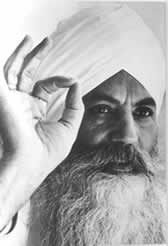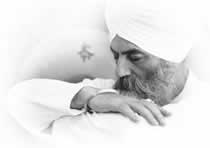
“I will tell you about yoga in very simple terms: The human mind is potentially infinite and creative. But in practical reality it is limited. So a technical know-how is required through which one can expand his mind to bring about the equilibrium that enables him to control his physical structure and experience his Infinite Self.”
— Yogi Bhajan
Kundalini Yoga (KY) is for everyone. You don’t need to be in great physical shape. As long as you can breathe and move your body it will work for you. The power lies in its experience. It actually goes right into your heart and core. No words can express that experience.
What is Kundalini Yoga?
KY is known as the Yoga of Awareness, a science that balances, clears, and energizes the aura or the Human Energy Field. Its goal is to discover your strengths and gifts, to be more relaxed, happy, and healthy in your daily life, and to live up to your challenges. Each class consists of a dynamic blend of postures (kriyas), breathing techniques (pranayam), deep relaxation (yoga nidra), mantras, music and meditations, which teaches you the art of surrender, self-healing, and elevation. The teachings of KY were brought to the West in 1968 by Yogi Bhajan (1929 – 2004). He made it his life task to spread its science and practice throughout the Western Hemisphere and beyond.
What does Kundalini Yoga do for you?
The practice of KY is enlivening. Even beginners will feel a sense of awakening, as the sequence of postures combined with breathing techniques are used to stimulate the nervous system and leave the mind sharp and alive. KY is an incredibly complete form of exercise for the muscles to maintain the strength and flexibility of the body. As the muscles are connected to the meridians or nadis (energy channels) our energetic body is strengthened and balanced. Due to the increased heart rate and internal massage of tissues and organs, KY increases the circulation of blood, lymph, and other body fluids. Thus the elimination of waste products through the lungs, intestines, kidneys, and skin is supported, strengthening our immune system and disease resistance. With its practice comes also a deeper understanding and perception of the chakras and the auric field, and how the practice of kriyas, pranayam, and meditation affects them.
Who can benefit from Kundalini Yoga?
KY supports us to master everyday life with more calmness and flexibility. It suits those of us who are looking for balance to a stressful job. It attracts people, who want to stay healthy and flexible, as well as those who are recovering from an accident or disease and want to regain their strength and balance. Also, it serves those who want to learn to breathe properly. The ability to deeply relax is essential for our well-being, on the physical, mental, and emotional level. Especially in our modern and hectic times, relaxation is difficult for a lot of people who tend to turn to TV, alcohol, or drugs to relax. KY will help to get over negative habits and teaches us to deeply relax. More specifically, KY can help you prevent or diminish back problems and improve your posture. Its practice relieves organic disfunctions or imbalances for the long term, as well as tensions and blockages on all levels (physical, emotional, mental).
What does a Kundalini Yoga class look like?
All kriyas (one or more postures in a specific sequence) that are taught were given by Yogi Bhajan. The following text will show you a brief description of a typical class. It’s best to start your practice with a trained teacher before you do it on your own at home.
1. Tuning in with Ong Namo
Each class begins with the Adi Mantra Ong Namo Guru Dev Namo. By reciting it three times we tune in as a group, center ourselves, and connect to the Golden Chain, the inner spark of Kundalini that links us to the masters and saints that came before us.
2. Warm-ups
After tuning in we start with pranayam and/or exercises (asanas). The goal here is to warm up our body, specifically the spine, before we go into more strenuous exercises, to quiet our mind, to open our energy channels, and start moving the energy. During most exercises and pranayam the eyes are closed and focused on the third eye point between the brows. Most often we are breathing through the nose and combine the breath with a mantra to help us deepen our experience and practice.
3. Kriya
A kriya consists of a set of asanas or exercises given by Yogi Bhajan. There are hundreds of sets with different themes to work on specific areas of the body and mind. For example, sets to strengthen and balance the aura, for flexibility and the spine, disease resistance, the glandular system, lungs and circulation, balancing sexual energy, releasing premenstrual tension, metabolism and relaxation, elevation, or for specific chakras. Each asana lasts in average 1 – 3 minutes depending on the class level. Short rests are given between exercises.
4. Long and deep relaxation
Deep relaxation in corpse pose (Shavasana) is not just the absence of movement. It brings profound relaxation to the whole body, allowing us to enjoy and consciously integrate the mind-body changes that we initiated through the practice of a kriya. In this state, we most likely are able to sense the extension of the self through the aura and magnetic field (Human Energy Field). During a 90 minute class this relaxation lasts about 10 – 15 minutes.

Meditation
As Yogi Bhajan explained, meditation is a process through which we can resolve conflict and misfortune, rather than playing it through in real life. Kundalini Yoga kriyas, breathing, and relaxation prepare us to receive the higher frequencies induced by meditation. Meditation teaches us to master our mind. Its effects on our whole being are tremendous, as numerous studies have shown. Hand positions (mudras) are an important part of meditation. Mudras lock and guide energy flow and reflexes to the brain. Yogi Bhajan left us with an endless amount of meditations. Meditations that use the breath, others that use mantras. Some meditations are done silently, others are chanted. As the kriyas, all meditations in KY are tailored to specific applications. There are healing meditations, meditations that work on addictions or fears, increase vitality, clear the chakras, for prosperity, to awaken the healer within, to name just a few examples.
5. Tuning out
We end each class with a little song written by the Incredible String Band.